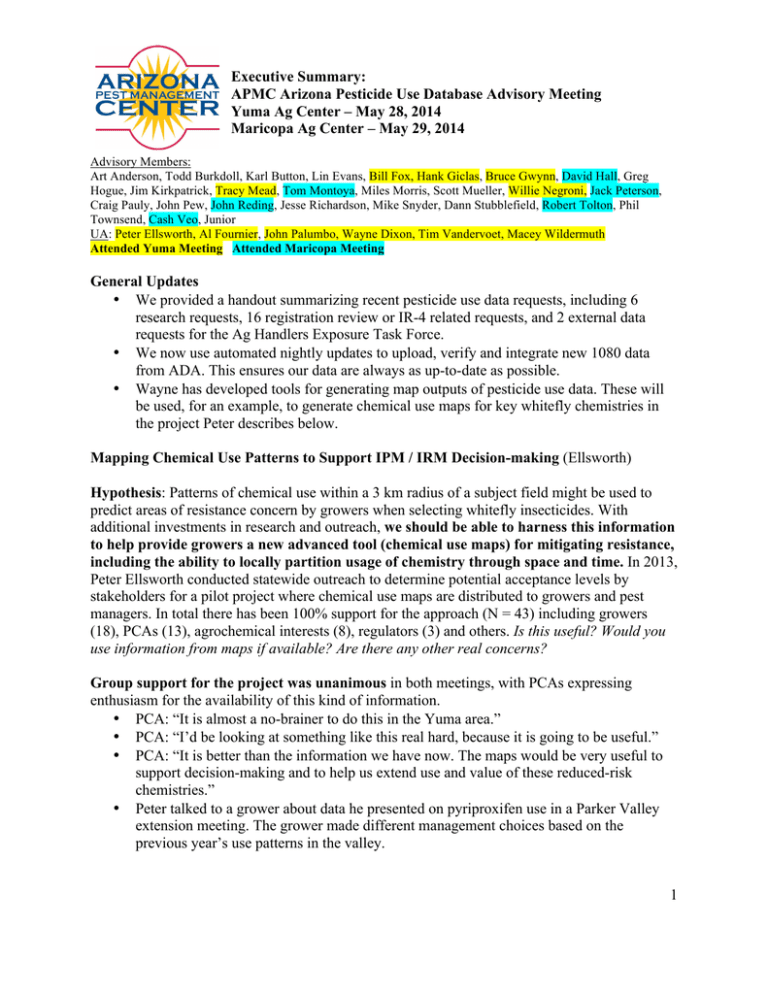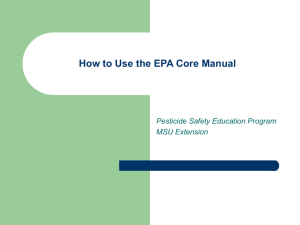Executive Summary: APMC Arizona Pesticide Use Database Advisory Meeting
advertisement

Executive Summary: APMC Arizona Pesticide Use Database Advisory Meeting Yuma Ag Center – May 28, 2014 Maricopa Ag Center – May 29, 2014 Advisory Members: Art Anderson, Todd Burkdoll, Karl Button, Lin Evans, Bill Fox, Hank Giclas, Bruce Gwynn, David Hall, Greg Hogue, Jim Kirkpatrick, Tracy Mead, Tom Montoya, Miles Morris, Scott Mueller, Willie Negroni, Jack Peterson, Craig Pauly, John Pew, John Reding, Jesse Richardson, Mike Snyder, Dann Stubblefield, Robert Tolton, Phil Townsend, Cash Veo, Junior UA: Peter Ellsworth, Al Fournier, John Palumbo, Wayne Dixon, Tim Vandervoet, Macey Wildermuth Attended Yuma Meeting Attended Maricopa Meeting General Updates • We provided a handout summarizing recent pesticide use data requests, including 6 research requests, 16 registration review or IR-4 related requests, and 2 external data requests for the Ag Handlers Exposure Task Force. • We now use automated nightly updates to upload, verify and integrate new 1080 data from ADA. This ensures our data are always as up-to-date as possible. • Wayne has developed tools for generating map outputs of pesticide use data. These will be used, for an example, to generate chemical use maps for key whitefly chemistries in the project Peter describes below. Mapping Chemical Use Patterns to Support IPM / IRM Decision-making (Ellsworth) Hypothesis: Patterns of chemical use within a 3 km radius of a subject field might be used to predict areas of resistance concern by growers when selecting whitefly insecticides. With additional investments in research and outreach, we should be able to harness this information to help provide growers a new advanced tool (chemical use maps) for mitigating resistance, including the ability to locally partition usage of chemistry through space and time. In 2013, Peter Ellsworth conducted statewide outreach to determine potential acceptance levels by stakeholders for a pilot project where chemical use maps are distributed to growers and pest managers. In total there has been 100% support for the approach (N = 43) including growers (18), PCAs (13), agrochemical interests (8), regulators (3) and others. Is this useful? Would you use information from maps if available? Are there any other real concerns? Group support for the project was unanimous in both meetings, with PCAs expressing enthusiasm for the availability of this kind of information. • PCA: “It is almost a no-brainer to do this in the Yuma area.” • PCA: “I’d be looking at something like this real hard, because it is going to be useful.” • PCA: “It is better than the information we have now. The maps would be very useful to support decision-making and to help us extend use and value of these reduced-risk chemistries.” • Peter talked to a grower about data he presented on pyriproxifen use in a Parker Valley extension meeting. The grower made different management choices based on the previous year’s use patterns in the valley. 1 • If we can document that these maps are helpful and track well with resistance management data, it would be an exciting new scientific outcome with great practical value. Assessing and Promoting the Safety of the AZ Lettuce Industry Peter provided a brief summary of data presented at last year’s advisory meeting, a historical risk analysis of Arizona lettuce pesticide use (also provided as a figure in a handout – see fig. 4 in http://cals.arizona.edu/apmc/docs/APMC%20Impact%20narrativep1-4_4-29-14.pdf). The upper 2 graphs in figure 4 show the number of sprays and pounds active ingredient used for broad spectrum and reduced-risk insecticides, 1991 – 2011. The bottom left of figure 4 shows the “risk score” (Y) and also the area affected by that score, as indicated by the size of the bubbles on the chart. We have shown a decline in use and risk by landmass, despite increasing lettuce production over this same period. This advisory board has always been very supportive of our work with the pesticide use data. But when we presented results from our risk analysis to this group last year, some concerns were expressed. It seems to us that these data show great progress in a progressive industry. We embarked on this project to support the industry, and we think these data would help the industry respond to any (inevitable, uninformed) challenges to industry pesticide practices. We hope these data can stand ready for when a dialog is had about risk within the agriculture industry. Ultimately, we would like to deploy workshops for PCAs to emphasize the use of ipmPRiME as a decision making tool, develop Extension publications related to pesticide risk/safety, and produce (as previously discussed) a technical report for the benefit of the industry. Much discussion ensued at both meetings on this topic. Take home messages: • • • • • • • • Some members expressed concerns about pursuing and especially publishing any results from pesticide risk analyses with ipmPRiME. Others recognized the potential value in these data, to arm the industry with scientific information on pesticide practices to counter anti-industry campaigns such as poorly informed “dirty dozen” list. Western Grower’s Association could use these data to tell a great story about the Arizona lettuce industry. This should be produced as a technical report with a limited audience: industry, regulators and researchers, not the general public. Some expressed concerns that any information about “risk” could be used against the industry. We should eliminate this word from our vocabulary and talk in terms of “environmental stewardship”, “improved outcomes”, or something similar. We need to emphasize that we have intelligent educated people (PCAs) making these pesticide recommendations. Bundle that with the message. This is a story that needs to be told and is ready to be told. It needs to be finished before the data are needed to respond to some crisis or criticism. It is a good thing, but don’t publish information on individual practices or specific products by name. Data would be presented in aggregate only. Differentiate between food safety and environmental safety in this discussion. Next Steps: We will produce a draft lettuce-focused industry report that this committee will have an opportunity to review and discuss further before anything is released. 2





